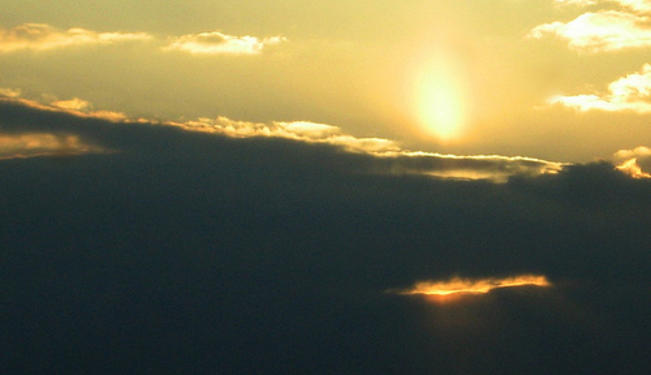Failure to comprehensively examine all the drivers of climate change may produce a false fear of a dangerously overheated planet.
Scientists of the Intergovernmental Panel of Climate Change (IPCC) are convinced that by using fossil fuels man is currently destroying the climate. But we do have one last chance; modern industrial society has to abandon its current way of living and allow itself to be revolutionized. They say that this will mean lots of hardship, but it is for a good cause. They also tell us that the scientific material that forms the basis of this warning is complex, in fact too complex for us to possibly understand. So it seems that we have to believe the climate experts. Even super computers have to calculate for several years in order to come up with the scary climate scenarios that are intended to convince the public and politicians that an urgent and costly change of direction is overdue.
But wait a moment. It should be a good practice to double check the underlying scientific facts before a major and costly change is being initiated. While many physical formulas may indeed be quite complicated and hard to verify or reject, we can use the large natural theater where “climate change” has been played out for many millions of years, to examine these claims of the IPCC scientists. With the help of geoscientists we have the chance to check how climate worked in pre-industrial times over the past 10,000 years when man-made CO2 did not play any major role. We can then concentrate only on natural climate drivers. According to the IPCC, natural factors hardly play any role in today’s climate. If we went by this, we would expect a rather flat and boring climate history.
But the big surprise comes when we look at the real, hard data. Reconstructions based on ice cores, dripstones, tree rings and ocean/lake sediment cores reveal that temperature history was characterized by significant temperature changes of more than 1°C. Warm and cold phases alternated, according to 1,000 year long cycles. This includes for example the Minoan Warm Time 3000 years ago and the Roman Warm Time 2000 years prior to today. During the Medieval Warm Phase around 1,000 years ago, Greenland was colonized and grapes suitable for winemaking were grown in England. In between the warm phases cold periods existed, including the Little Ice Age from the 15th to the19th century. All these temperature fluctuations occurred during the time when the CO2-content of the atmosphere was essentially stable. Therefore only natural processes could have been responsible for those historic climate variations.
What natural driver could this be? It was the late Gerard Bond, Professor of Geology at the Lamont-Doherty Earth Observatory in Palisades, New York who started to unravel the puzzle. Based on climate reconstructions from North Atlantic deep-sea sediment cores, he discovered that the millennial-scale climate cycles run largely parallel to changes in solar activity. The nuclear fusion reactor of our sun exhibits characteristic changes that are manifested by a whole series of solar cycles. One of the most important is the so-called Eddy cycle that is 1,000 years long. So it is really our sun that has shaped the temperature roller coaster of the past 10,000 years.
The past is the key to the present, and to the future. The data reveal the pre-industrial natural climate pattern of the past: when the sun was active, temperatures were high; and when the sun took a rest, temperatures were low. The two were always intimately linked in pre-industrial times. But then the age of coal, oil and natural gas arrived. From the 1850s onwards man pumped large amounts of carbon dioxide into the atmosphere. The atmospheric CO2 concentration began to rise. Today, the CO2-level is a modest 0.039%, compared to 0.028% previously.
Let us consider for a moment, how modern climate since 1850 would have looked like if the natural pattern simply continued. The year 1850 marks the end of the mentioned Little Ice Age, a natural cold phase associated with low solar activity. Based on the natural pattern, we predicted that solar activity climbed since 1850, more or less parallel with an increase in temperatures. When we compare this prediction with real world climate data for the past 160 years, we are surprised to learn that this is exactly what happened. Both the timing and amount of warming by nearly 1°C fit nicely into the natural scheme. The solar magnetic field more than doubled over the past 100 years. According to the solar physicist Sami Solanki, the past decades were among the most active ones of the last 10,000 years, in terms of solar activity.
Therefore, does it really make sense to assume that the sun has nothing to do with modern climate warming, as IPCC does? There are three climate parameters that increase at the same time: solar activity, CO2 levels, and temperature. The key scientific task is not to eliminate either the sun or CO2 out of the climate equation but rather to determine the individual contribution of the two climate driver candidates to the measured warming of 0.8°C since 1850. This is not to say that CO2 has no climatic significance. Modern climate is likely to be driven by both anthropogenic and natural processes. CO2 will undoubtedly have contributed to the warming, but the question is how much? The stronger the natural processes turn out to be, the smaller is the role of CO2 in the warming that occurred within the past 160 years since the end of the Little Ice Age. It was the uncomfortable cold of the Little Ice Age that we selected as our reference temperature for such calculations.
Despite all this, the IPCC in their computer models consider the solar effects as negligible. Their stated reason is that solar activity changes alone are physically too weak and require an amplifying mechanism to account for the observed temperature variations. A promising model for exactly such an amplifying model has been proposed by the Danish physicist Henrik Svensmark, but is still in the process of being researched. Surprisingly, the IPCC chose to ignore the inconvenient solar climate driver altogether, on the basis that the physical amplification mechanism is still not fully understood and under debate. By doing this, however, the IPCC runs into the serious problem that its current climate models cannot explain the climate history of the past 10,000 years. But if these models fail so dramatically in corroborating evidence from the past, can we really expect them to be of great help for future climate predictions? Clearly, models without a proper history match have little to no predictive power – this is well known in all other fields of science and engineering.
What is little known in the public is that CO2 also requires a strong amplifier if it is to aggressively shape future climate as envisaged by the IPCC. CO2 alone without the so-called feedbacks would only generate a moderate warming of 1.1°C per CO2 doubling. The IPCC now assumes that strong amplification processes are at work, including water vapour and cloud effects, which, like the solar amplification candidates, are also still poorly understood. In the case of CO2, the limited knowledge of the physical process did not stop the IPCC from making wide use of such amplifiers in their virtual climate computer models. It is these shaky foundations on which the IPCC bases its alarming prognoses of a temperature rise of up to 4.5°C for each doubling of CO2.
Most solar physicists forecast that solar activity will decline significantly over the coming decades, a process that has already started showing in the past few years. For example, in 2010 the intensity of the solar magnetic field dropped to one of its lowest levels in the last 150 years. This means the sun will be set at its low burn mode for the decades ahead. Given the significant solar contribution to climate change in the past and the probably lower climate significance of CO2 than suggested by the IPCC, global warming may be halted for a while, until it resumes at a low pace around 2030/2040. From calculations honouring the natural climate pattern of the past, we expect that by 2100 temperatures will not rise by more than 1°C. This is drastically less than the temperature rise advocated by the IPCC It therefore becomes ever clearer that climate catastrophe is called off and the fear of a dangerously overheated planet will soon go down in the history books as a classical science error.
Once the dust of the heated climate debate has settled, it must be hoped that certain scientists will return to reason and start considering the whole set of evidence, and not just a selective part that best fits with their once-championed story. Rather than being largely settled, the debate continues and further climate questions need to be addressed in a neutral and open-minded way.
What are the political implications of this historical scientific misunderstanding? Firstly, we need a comprehensive research program focusing on the underestimated role of natural climate drivers. Secondly, the warming pause over the coming decades gives us time to convert our energy supply in a planned and sustainable way, without having to incur a massive loss of prosperity. This will also profoundly change the setting of priorities for an energy agenda. It will unleash much-needed resources to assure an adequate supply of food, water, and a rising standard of living globally. Factors concerning economic feasibility or social justice again will equitably decide energy policy along with climate protection. By understanding that natural climate factors will also play an important role in the future, we gain time – precious time – for rational decarbonizing. This decarbonizing can be achieved by implementing new, renewable technologies, through higher energy efficiency and better material consumption, and by improving the generation of conventional fossil energy in a rational, cost-saving, and truly sustainable way. Because today’s climate politics decide the distribution of economic growth, they also decide on prosperity growth over the coming decades.
The views expressed in this article are the author’s own and do not necessarily reflect Fair Observer’s editorial policy.
Support Fair Observer
We rely on your support for our independence, diversity and quality.
For more than 10 years, Fair Observer has been free, fair and independent. No billionaire owns us, no advertisers control us. We are a reader-supported nonprofit. Unlike many other publications, we keep our content free for readers regardless of where they live or whether they can afford to pay. We have no paywalls and no ads.
In the post-truth era of fake news, echo chambers and filter bubbles, we publish a plurality of perspectives from around the world. Anyone can publish with us, but everyone goes through a rigorous editorial process. So, you get fact-checked, well-reasoned content instead of noise.
We publish 2,500+ voices from 90+ countries. We also conduct education and training programs
on subjects ranging from digital media and journalism to writing and critical thinking. This
doesn’t come cheap. Servers, editors, trainers and web developers cost
money.
Please consider supporting us on a regular basis as a recurring donor or a
sustaining member.
Will you support FO’s journalism?
We rely on your support for our independence, diversity and quality.








Comment